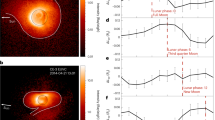Abstract
Saturn’s moon Enceladus emits a plume of water vapour and micrometre-sized ice particles from a series of warm fissures located near its south pole1,2,3,4,5,6,7,8,9,10. This geological activity could be powered or controlled by variations in the tidal stresses experienced by Enceladus as it moves around its slightly eccentric orbit. The specific mechanisms by which these varying stresses are converted into heat, however, are still being debated11,12,13,14,15,16. Furthermore, it has proved difficult to find a clear correlation between the predicted tidal forces and measured temporal variations in the plume’s gas content17,18,19 or the particle flux from individual sources20,21. Here we report that the plume’s horizontally integrated brightness is several times greater when Enceladus is near the point in its eccentric orbit where it is furthest from Saturn (apocentre) than it is when near the point of closest approach to the planet (pericentre). More material therefore seems to be escaping from beneath Enceladus’ surface at times when geophysical models predict its fissures should be under tension12,15,16 and therefore may be wider open.




Similar content being viewed by others
References
Spencer, J. R. et al. in Saturn from Cassini-Huygens (eds Dougherty, M. K., Esposito, L. W. & Krimigis, S. M. ) 683–724 (Springer, 2009)
Dougherty, M. K. et al. Identification of a dynamic atmosphere at Enceladus with the Cassini Magnetometer. Science 311, 1406–1409 (2006)
Hansen, C. J. et al. Enceladus’ water vapor plume. Science 311, 1422–1425 (2006)
Waite, J. H. et al. Cassini Ion and Neutral Mass Spectrometer: Enceladus plume composition and structure. Science 311, 1419–1422 (2006)
Porco, C. C. et al. Cassini observes the active south pole of Enceladus. Science 311, 1393–1401 (2006)
Ingersoll, A. P. & Ewald, S. P. Total particulate mass in Enceladus plumes and mass of Saturn’s E ring inferred from Cassini ISS images. Icarus 216, 492–506 (2011)
Hedman, M. M. et al. Spectral observations of the Enceladus plume with Cassini-VIMS. Astrophys. J. 693, 1749–1762 (2009)
Postberg, F. et al. The E-ring in the vicinity of Enceladus. Icarus 193, 438–454 (2008)
Postberg, F., Schmidt, J., Hillier, J., Kempf, S. & Srama, R. A salt-water reservoir as the source of a compositionally stratified plume on Enceladus. Nature 474, 620–622 (2011)
Spencer, J. R. et al. Cassini encounters Enceladus: background and the discovery of a south polar hot spot. Science 311, 1401–1405 (2006)
Nimmo, F., Spencer, J. R., Pappalardo, R. T. & Mullen, M. E. Shear heating as the origin of the plumes and heat flux on Enceladus. Nature 447, 289–291 (2007)
Hurford, T. A., Helfenstein, P., Hoppa, G. V., Greenberg, R. & Bills, B. G. Eruptions arising from tidally controlled periodic openings of rifts on Enceladus. Nature 447, 292–294 (2007)
Meyer, J. & Wisdom, J. Tidal heating in Enceladus. Icarus 188, 535–539 (2007)
Tobie, G., Cadek, O. & Sotin, C. Solid tidal friction above a liquid water reservoir as the origin of the south pole hotspot on Enceladus. Icarus 196, 642–652 (2008)
Smith-Konter, B. & Pappalardo, R. T. Tidally driven stress accumulation and shear failure of Enceladus’s tiger stripes. Icarus 198, 435–451 (2008)
Hurford, T. A. et al. Geological implications of a physical libration on Enceladus. Icarus 203, 541–552 (2009)
Saur, J. et al. Evidence for temporal variability of Enceladus’ gas jets: modeling of Cassini observations. Geophys. Res. Lett. 35, L20105 (2008)
Smith, H. T. et al. Enceladus plume variability and the neutral gas densities in Saturn’s magnetosphere. J. Geophys. Res. 115, A10252 (2010)
Hansen, C. J. et al. The composition and structure of the Enceladus plume. Geophys. Res. Lett. 38, L11202 (2011)
Porco, C. et al. Jetting activity and thermal emission across the south polar terrain of Enceladus: observations and comparisons with shear-heating models. AGU Fall Meet. Abstr. P13F-02. (2011)
Hurford, T. A., Helfenstein, P. & Spitale, J. N. Tidal control of jet eruptions on Enceladus as observed by Cassini ISS between 2005 and 2007. Icarus 220, 896–903 (2012)
Brown, R. H. et al. The Cassini Visual and Infrared Mapping Spectrometer (VIMS) investigation. Space Sci. Rev. 115, 111–168 (2004)
Schmidt, J., Brilliantov, N., Spahn, F. & Kempf, S. Slow dust in Enceladus’ plume from condensation and wall collisions in tiger stripe fractures. Nature 451, 685–688 (2008)
Acknowledgements
We acknowledge the support of the VIMS team, the Cassini project and NASA. This work was supported in part by NASA grant NNX12AC29G. The work of C.M.G. on this project was made possible by the Research Experience for Undergraduates programme at Cornell University.
Author information
Authors and Affiliations
Contributions
M.M.H., C.M.G. and P.D.N. performed the data analysis. R.N.C., along with P.D.N., C.S., R.H.B., K.H.B. and B.J.B., planned the observations, and provided the data from the VIMS instrument and the appropriate calibration routines. M.R.S. supported the photometric interpretation of these data. All authors discussed these results.
Corresponding author
Ethics declarations
Competing interests
The authors declare no competing financial interests.
Supplementary information
Supplementary Information
This file contains Supplementary Text, Supplementary Figures 1-2 and Supplementary Table 1. (PDF 518 kb)
Rights and permissions
About this article
Cite this article
Hedman, M., Gosmeyer, C., Nicholson, P. et al. An observed correlation between plume activity and tidal stresses on Enceladus. Nature 500, 182–184 (2013). https://doi.org/10.1038/nature12371
Received:
Accepted:
Published:
Issue Date:
DOI: https://doi.org/10.1038/nature12371
- Springer Nature Limited
This article is cited by
-
Sustained and comparative habitability beyond Earth
Nature Astronomy (2023)
-
Enceladus and Titan: emerging worlds of the Solar System
Experimental Astronomy (2022)
-
Enceladus as a potential oasis for life: Science goals and investigations for future explorations
Experimental Astronomy (2022)
-
Ice-Ocean Exchange Processes in the Jovian and Saturnian Satellites
Space Science Reviews (2020)
-
Key Technologies and Instrumentation for Subsurface Exploration of Ocean Worlds
Space Science Reviews (2020)





